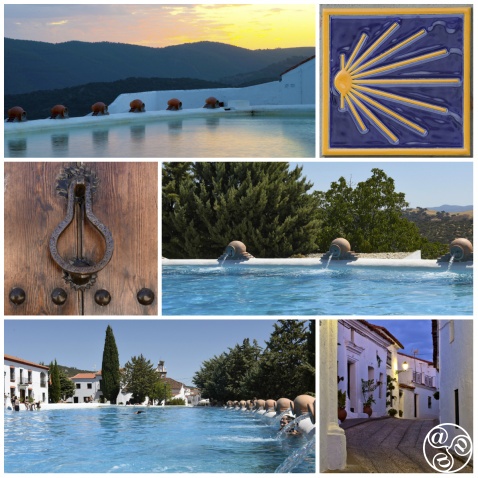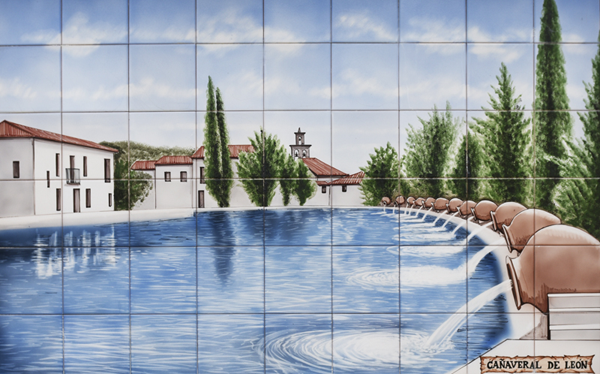
Canaveral de León, Sierra de Aracena, Andalucia |
|
Cañaveral de León
by Saskia Mier
Cañaveral de León is located within the Sierra de Aracena and Picos de Aroche Natural Park to the north of Aracena and only one kilometre from the Extramadura border. It has a population of about 400.
The centre of Cañaveral de León boasts typical Andalusian-style houses along cobbled streets, as well as several mansions that are beautifully preserved.
HISTORY
The name Cañaveral de León comes from the dependence on the Encomienda Mayor de León (group of five small villages). Cañaveral means reed bed that probably existed near an important water source in the centre of the town.
The area was first populated between the third and second millennium BC during the Chalcolithic period (Copper Age, an early part of the Bronze Age) as there is an interesting archaeological site in the nearby Sierra del Jacaco.
The lands belonging to the Priorato de San Marcos de León (diocese of the Priory of St Mark of the Lion) were conquered from the Arabs in the mid-13th century by the Order of Santiago, which was commissioned to repopulate the area with inhabitants from the Kingdoms of Castilla and León.
Felipe II granted Cañaveral de Leon its 'village' title in 1588 and from 1591 to 1598 it continued to have royal privileges and jurisdictions. From then until the 19th century, the town belonged to the Reino (Kingdom) of León. During the reign of Isabel II, as part of the Spanish territorial reform of 1833, it became part of the newly-created province of Huelva.
LA LAGUNA
La Laguna, a pool measuring 8000m2, is located in the central square of Cañaveral de León and is without a doubt one of the most unique features of the village. It has been enjoyed for years by residents and tourists that go there to swim every summer and is an absolutely remarkable experience.
La Laguna holds 1.5 million litres of water and has existed for over 100 years as a lagoon to store water for irrigating the local orchards and vegetable plots. The water comes directly from the spring and, apart from powering the olive mill, some say that bathing in the water has medicinal benefits. It was cleaned and renovated in 2004 and requires surprisingly little cleaning and maintenance. Open all year round but only cleaned in the summer and fed chlorine.
The Plaza del Ayuntamiento is where you will find La Laguna, located right outside the front door of the town hall itself. A few shaded areas around as well as a café that serves drinks and snacks throughout the day. Although very popular in the summer with both residents and tourists from Seville, it is not crowded. Open 24 hours and no fee for usage.
The video below is a news item from the regional television, showing how vistors come from far and wide to the tiny village of Cañaveral de León to enjoy a summer dip.
THINGS TO SEE
Iglesia Parroquial de Santa Maria Martir
One of the main sites of the Cañaveral de León is the Iglesia Parroquial de Santa Maria Martir (chapel), patron of the town, built in the 15th century and renovated in the 18th century.
Ermita de la Virgen de Fatima
Ermita de la Virgen de Fatima (chapel) is a modern building from the 1980s.
Fuente Redonda
The Arabic Fuente Redonda (Round Fountain) is historically important. It was initially designed to irrigate local vegetable plots and is fed by an aquifer that runs underneath the village houses. The water flowing from it runs along a long open canal before emptying into La Laguna (lagoon).
Molino de Marquez
Museo Etnologico de Aceite (Ethnological Museum of Olive Oil) is located next to the Laguna. Also called Molino de Marquez it is the only museum of its kind in the province of Huelva and is located in a renovated oil mill used for the museum, public library and a multipurpose building. The mill was built in around 1805 by Tomas Marquez Jarillo, a local businessman who, after buying several olive groves, decided to build a mill. All the machinery was brought in Seville, while the stone and curler were transported from the mines of Cala. It was a working mill for over a century and a half, until the 1960s when many village residents moved to other areas of Spain. The mill has undergone a complete renovation, while respecting the existing material and detail.
Camino de Santiago
When visiting Cañaveral de León, you will see signs for the Camino de Santiago. It is actually part of Camino Sur (southern route) of the Camino the Santiago, which starts in Huelva moving up through Zafra (Extremadura) and later linking up with Via Camino de la Plata (silver route). Cañaveral de Leon is the last village in the province of Huelva on the Camino Sur (southern route), the idea being to use the village to divide this walk route, specifically the route through Aracena which spans a distance of 28km. Cañaveral de León has a punto de acogida (resting point) where pilgrims can rest for a night before continuing on the Camino de Santiago, as well as obtaining a certificate stating the section of the route walked.
Hotels near Cañaveral de León
Book Hotels near Cañaveral de León
GASTRONOMY
Cañaveral de León offers dishes such as black pudding stew, arroz de matanza (rice with Iberian pork), spiced black pudding, migas serranas (mountain fried breadcrumbs with chorizo) or gazpacho (cold tomato soup).
A wide variety of sweet treats can also be found on Cañaveral de León, including perrunillas (butter biscuits), muffins, santaneros (sweet folded pastry), roscos (similar to doughnuts), lazos (pastry bows), canutos (pastry rolls), gañotes (honey pastries), buñelos (fried profiteroles) and tortas de chicharrones (flatbread made with pork scratchings).
HANDICRAFTS
Weaving is particularly popular in Cañaveral de León due to the huge source of olive trees in the area. Olive branches are cleaned and prepped to weave baskets of all shapes and sizes as well as other ornamental pieces. Textiles, specifically flamenco dress-making, are increasing in popularity in the area which has been helped by fashion shows and events created in the village, specifically the Certamen de Moda Flamenca held every July to exhibit the work of local designers.
FESTIVITES
Cañaveral de León celebrates numerous festivities.
Santa Marina Martir Romeria
Celebrated the first weekend of July. On Friday afternoon a floral wreath is created and at 9am the next morning a church service is held for all pilgrims followed by the procession of the patron saint to the banks of the river Montemayor.
Santa Marina Festival
Held from 17-21 July in honour of Santa Marina Martir and on the 18th, a procession is organised accompanied by music and dancing.
Dia de la Vaca
Celebrated on the 19 July. A few days before this date a small bullring is built on the sand. The public await the band and dance until 7pm when the bullfighting starts.
La Campanillada is a curious celebration where bells are played to couples who have separated and come together again.
Corpus Christi
A religious festival held on the Sunday, with a procession though the village and a raffle of homemade sweet treats at the entrance of the church to raise money for the local festivities or for a social event.
LOCATION
Cañaveral de León is located 195km from Huelva. From the city centre travel along Avenida de Cádiz and H-30, taking exit 10-A in the direction of Seville, and follow the A-49 until it joins the SE-30 Seville ring road. Leave on the Merida exit to join the A-66, drop onto the N-630 at Santa Ana de Olalla and then join the A-434. Cross Cala and Arroyomolinos de León and the A-5300 you will reach Cañaveral de León.


